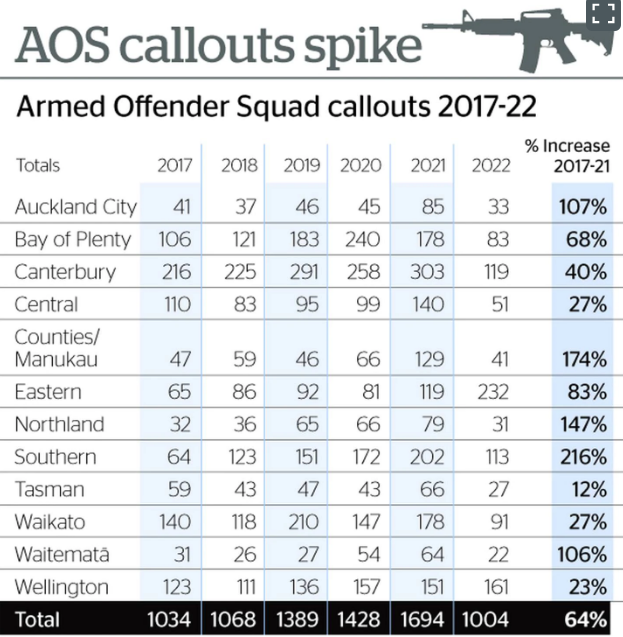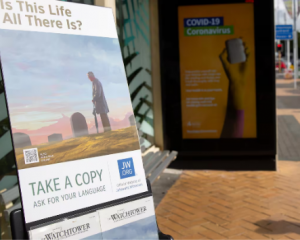
Meanwhile, a frank paper from the police executive reveals frontline staff are increasingly finding calls too risky to attend and dog handlers are regularly putting their lives on the line.
But Police Minister Chris Hipkins denies New Zealand has reached the point of American-style militarised policing, despite the country clocking more than 1000 armed offenders squads (AOS) deployments this year alone.
Figures obtained by National police spokesman Mark Mitchell via written parliamentary questions show a 64 per cent overall increase in AOS callouts from 2017, when there were 1034 nationally, to 1694 last year.
This year alone, there have been 1004 in the year to July, meaning 2022 is on track to be another record year for AOS callouts at the current rate.
Since 2017, all of New Zealand's 12 police districts have recorded an increase in AOS callouts, five of them more than double in 2021: Waitematā (106 per cent), Auckland City (107 per cent), Northland (147 per cent), Counties Manukau (174 per cent) and Southern (216 per cent).
But it is the Eastern District, spanning from the top of the East Cape to southern Hawke's Bay, that stands out in 2022 for AOS callouts, recording 232, more than double most other districts.In May alone there were 86 deployments in Eastern, of which 83 were pre-planned.
June also had more than one per day.
Inspector Andrew Sloan, acting Eastern District Commander, said that was the result of major operations targeting gangs in Hawke's Bay and Tairāwhiti.

As part of that operation a raid found a man who was allegedly producing home-made firearms and explosives. Officers who descended on the Hawke's Bay property found several home-made pistols and IEDs.
Operation Kotare centred on gang violence and a spate of drive-by shootings in Wairoa and Tairawhiti.
Sloan said Bloodhound and Kotare accounted for 79 of the AOS deployments in Eastern in May this year.
"AOS were deployed in support of pre-planned execution of search warrants relating to these operations, due to the higher risk posed to general duties officers executing the warrants," he said.
"Additionally, reassurance patrols including AOS personnel are conducted following high-profile violent offending incidents, to provide community reassurance and increase the availability of tactically trained staff to support the frontline.
"Sometimes these reassurance patrols run 24/7, and each patrol is noted as a separate AOS deployment."
Mitchell said he believed the numbers were a result of a rise in high-level organised crime involving offenders more willing to use firearms.
"I think it's a clear response to serious, top-end offending," he said.
But he did not think New Zealand should break with tradition and introduce a routinely armed force.
"As a general policy, we're against general arming."
In 2019, a few months after the Christchurch Mosque terror attacks, police introduced a trial of Armed Response Teams (ARTs), mobile units of officers equipped with guns ready to respond at short notice.They were dumped after a six-month trial in Canterbury, Counties Manukau and Waikato amid criticism over a lack of consultation with Māori and claims they targeted marginalised communities.
Police Commissioner Andrew Coster said in 2020 the teams, unveiled by his predecessor Mike Bush, did not fit with the style of policing Kiwis were used to.
Mitchell told the Herald he would have retained the ART model if in Government.
In 2021, the police executive agreed to trial a new Tactical Response Model (TRM).
A governance paper prepared for the police Executive Leadership Team in July 2021, released to the Herald under the Official Information Act, cited concern among officers about the level of sophistication of organised crime groups because of the impact of 501 deportees from Australia.

"Frontline staff have said they increasingly find themselves in situations where they feel ill-equipped and unsafe.
"This is often due to a combination of feeling inadequately trained or supported, alongside the known - and unknown - risks from firearms and violent offenders they encounter in their day-to-day work."
The paper said some staff were avoiding high-risk jobs because they felt unprepared and unsafe.
The proposed TRM model more than doubled tactical training - including firearms instruction - for frontline officers, and would create up to 60 new AOS staff.
It also suggested making dog units double crewed, meaning the dog hander, who typically works alone with the dog, would be joined by an AOS-level officer.
"Being a dog handler is often referred to as the most dangerous job in police," the paper said.
"They are often required to hunt for unknown offenders, in unfamiliar surrounds, during the day or at night – without support," the paper said.
Late last year Coster announced the Northland and Central districts would be testing a full version of TRM, and Counties Manukau and Waikato would trial parts of the model.
Police Minister Chris Hipkins declined an interview request but said in a statement the police focus on gang activities had resulted in an increased need for AOS deployments.
"It does not indicate higher levels of gun crime; rather it's a sign this Government has less tolerance for illegal guns, and criminal gang behaviour than the previous National Government."
Asked if he was concerned about New Zealand moving more towards an American style of armed policing, Hipkins said he "disagreed strongly with that assessment".
"In New Zealand we have a community-based approach to policing, working with iwi and communities to police by consent," the statement said.
"Policing at the occupation at Parliament and at roadblocks during the pandemic are testament to this approach.
"In terms of police's tactical approach, its focus is on ensuring that tactical operators and frontline specialists have the right training, equipment and support to ensure they can appropriately respond to all situations they face."












